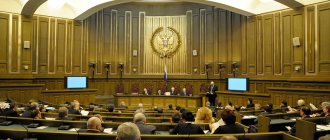Research part
Facts of the case:
It follows from the resolution that: “04.10.2015, at approximately 19:30, an unidentified person, while in the understreet passage of the Proletarskaya station in Moscow, during a conflict with M.S., struck the latter at least two times with his hand to the face area, after which M.S. was applied. one punch to the head area, causing him to hit his head on the floor, thereby causing M.S. bodily injuries resulting, according to a certificate from the intensive care unit for emergency patients, of the Research Institute for Emergency Medicine named after. N.V. Sklifosovsky “open traumatic brain injury: severe brain contusion. Acute subdural hematoma of the right frontal-temporal-parietal-occipital region 105 cm3. Edema, ischemia, brain dislocation.” In this criminal case, it is necessary to establish the severity of the harm to health caused to M.S., born on January 25, 1960. I allow, at the discretion of the forensic medical expert, the involvement of experts and doctors of other specialties to produce SM.” Forensic medical examination is carried out using medical documents.
- From a copy of the expert’s conclusion No. 2014m/1616 dated February 26, 2016, performed in No. 5 of the Moscow State Budgetary Institution “Department of Forensic Medical Examination of the Moscow City Health Department”, it follows: Damage to Mr. M.S., born in 1960: Closed traumatic brain injury: severe brain contusion, acute subdural hematoma in the right frontal-temporoparietal-occipital region with edema, ischemia and dislocation of the brain; bruise in the occipital region. This injury could have appeared within the period specified in the resolution. The anatomical location and nature of the noted lesions correspond to the opposite sides of the head, indicating that M.S. traumatic brain injury due to inertial head injury, which is characterized by an impact with a moving head on a wide hard surface of a massive stationary object. In this case, the occurrence of an inertial head injury may be situationally associated with M.S.’s fall. from the initial standing position backwards, which ended with a blow to the occipital region against a blunt hard object with the predominant surface of impact. This traumatic brain injury caused serious harm to health, which is dangerous to human life. The nature of this injury does not exclude the possibility of its formation during a spontaneous or pre-accelerated fall from a height of one’s own height and the body colliding with a plane surface or when the occipital region hits a wall...”
- From a copy of the additional expert opinion No. 820/6094 performed in No. 5 of the Moscow State Budgetary Institution "Department of Forensic Medical Examination of the Moscow City Health Department", it follows: Based on the data provided to the expert from medical documents, data from a forensic medical examination, taking into account the circumstances case, and also taking into account the questions posed to the expert, using the method of expert analysis, I come to the following: Damage to Mr. M.S., born in 1960: Traumatic brain injury: severe brain contusion, acute subdural hematoma in the right frontal-temporal-parietal-occipital region with edema, ischemia and dislocation of the brain; fracture of the base of the skull, hemosinus and hemotympanum on the left, bruise in the occipital region on the left. This injury could have occurred within the period specified in the resolution. The anatomical location and nature of the noted lesions correspond to the opposite sides of the head and indicate that M.S. traumatic brain injury as a result of inertial head injury, which is characterized by an impact with a moving head on a wide hard surface of a massive stationary object. In this case, the occurrence of an inertial head injury may situationally be caused by the fall of M.S. from the starting position standing backwards, with a turn to the left during the fall, which ended with a blow to the left occipital region against a blunt hard object with the predominant impact surface. This traumatic brain injury caused serious harm to health, dangerous to human life. M.S. suffered from severe traumatic brain injury. Born in 1960, with a closed fracture of the nasal bones on the left with minimal displacement of the fragments. Such a fracture could have formed within the period specified in the resolution from the impact of a hard blunt object with the application of traumatic force to the nose area, mainly in the direction from front to left to back, and caused minor health problems, causing short-term health problems lasting up to three weeks. An injury such as a “fracture of the nasal bones” is not life-threatening in the medical sense. The legal assessment of bodily injuries is not within the competence of the forensic medical examination.
Features of the fall of M.S. The findings noted in the previous paragraphs confirm the possibility of his falling after being hit with a hard blunt object in the nose area.
The mechanism of formation of the above bodily injuries excludes the possibility of their formation “when hitting your head against a wall.”
According to paragraph No. 10. Appendix of Order M3 of Social Development of the Russian Federation dated April 24, 2008 No. 194n, the above injuries are not assessed according to the qualifying criterion of “loss of ability to work”..."
Expertise and questions to the expert
When drawing up a document appointing an examination, special attention must be paid to determining its type, as well as the correctness of the questions for the upcoming study. Expertise conducted in Russia is usually classified based on the type of research, as well as the procedure for conducting it.
All types of research conducted in Russia by government institutions are indicated in the appendix to the order of the Ministry of Justice of the Russian Federation “On approval...” dated December 27, 2012 No. 237. According to this list, in 2018, 27 types of expert research are carried out in the Russian Federation, with each as a subject various objects may appear. For example, within the framework of biological examination, various objects of the animal and plant world can be examined, within the framework of handwriting examination - signatures of persons, handwriting samples, etc.
In practice, the questions posed often cover several areas of knowledge, so a comprehensive examination with the participation of several experts is required. An examination of this kind, according to Article 82 of the Code of Civil Procedure, is entrusted by the court to several experts, but in the end a single conclusion is prepared, in which a general conclusion is formulated. The conclusion itself is signed by all specialists who took part in the examination.
Also, in particularly complex cases, a specific study may be entrusted to several experts of the same specialty. In this case, according to Article 83 of the Code of Civil Procedure of the Russian Federation, a commission examination is carried out, the result of which is also a general conclusion of several experts (but of the same specialty).
In what cases is a portrait examination necessary?
Portrait examination is carried out in criminal (theft of property, theft of money from ATMs, robbery, terrorism) and civil cases, in situations where it is necessary to establish the identity or difference of the appearance of persons:
- when establishing the identity or difference in the appearance of the wanted criminal and the person who aroused suspicion;
- when establishing the identity or difference between the appearance of a missing person and the signs captured in photographs of corpses or living persons;
- when establishing the identity or difference in the appearance of a missing person and a fugitive criminal;
- when establishing the identity or difference of features of the appearance of persons in photographs in several documents that are issued to different persons;
- when identifying the corpses of unidentified persons;
- in other situations
When is a forensic examination ordered?
Forensic examination - concept and procedure Read more Forensic examination is prescribed when issues arise that require special knowledge in various fields.
Forensic examination is the one. which was appointed during a trial or during an inquiry or investigation in a criminal case (yes, an examination during an investigation is also called judicial). The examination is carried out by persons with special knowledge - experts, forensic institutions.
Sometimes an official has the right to decide whether or not to order an examination. In other cases, an examination is mandatory. If a mandatory examination is not carried out in criminal proceedings, the case cannot be brought to court. In civil and arbitration proceedings there is no formally obligatory examination, but in practice everyone knows that if in the case of, for example, a boundary dispute,
When is it necessary to appoint an examination in civil and arbitration proceedings?
Neither the Arbitration Procedural Code of the Russian Federation (APC RF) nor the Civil Procedure Code of the Russian Federation (CPC RF) stipulate specific cases of conducting an examination. The Code of Civil Procedure of the Russian Federation clarifies that an examination is prescribed when special knowledge is needed in various fields of science, technology, craft, and art (clause 1 of Article 79 of the Code of Civil Procedure of the Russian Federation).
According to the Arbitration Procedure Code of the Russian Federation, an examination is prescribed when questions arise that require special knowledge. A special case of ordering an examination is given - the need to verify a statement about falsification of the presented evidence (clause 1 of Article 82 of the Arbitration Procedure Code of the Russian Federation).
When is it necessary to appoint an expert examination in a criminal trial?
In criminal cases, the appointment of an examination during the investigation may be mandatory (Article 196 of the Criminal Procedure Code as amended on June 17, 2021), if
- the causes of death are unclear,
- harm caused to health,
- the suspect or accused behaves in a way that casts doubt on his sanity or ability to independently defend himself in the process, testify, or there are suspicions that he is a drug addict
- a crime has been committed against the sexual integrity of a person under 14 years of age and it is necessary to find out the presence of a disorder such as pedophilia,
- it is necessary to accurately establish the age of the suspect, accused, victim, because it depends on age whether the suspect is subject to criminal liability or qualifications (choice of article of the Criminal Code of the Russian Federation).
What materials must be provided for a portrait examination?
To conduct a forensic portrait examination or extrajudicial research, it is necessary to provide the following materials: photographs or video recordings depicting the appearance of an unknown person, comparative samples (photos or video recordings depicting the appearance of the person being checked).
During the research, the expert may request additional information: information about whether the person being tested has brothers or sisters, medical information (about diseases, operations, injuries, etc.).
Images submitted for examination are checked for suitability. Suitability depends on the presence and degree of manifestation of physical characteristics of the persons being compared. For this reason, the effectiveness of the research (categoricalness, probability of the conclusion, or the inability to answer the questions posed) depends on the quality of the objects provided: it is recommended to provide the original photograph or high-quality copies.
Images of faces to be compared must be comparable in a number of ways: age, angle.
The object of portrait examination is not non-objective images (portraits, drawings, sculpture, verbal description).
What questions are posed to the expert?
- Are the same or different faces shown in the photographs (video footage) of the unknown person and the photographs (video footage) presented for comparison?
- Are the same or different faces shown in the photograph and x-ray?
- Do the parts of the head, face, body depicted in the presented photographs (x-rays) belong to the same or different people?
- Does the skull submitted for research belong to the person depicted in photographs (video recordings, x-rays)?
- Are several photographs of unknown persons showing the same or different faces?
- What is the gender, approximate age, anthropological type of the person captured in the photograph (video recording)?
IMPORTANT
The list of suggested questions is not exhaustive. If other questions arise, it is advisable to seek advice from an expert before scheduling an examination.




